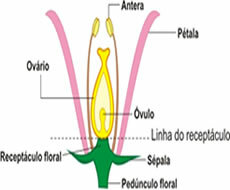Diatoms are unicellular, photosynthetic algae found in fresh and salt water alone or forming colonies. They are very important in the composition of phytoplankton, thus constituting the basis of the food chain. Its pigments are mainly yellow to brown, located inside the chromoplasts.
It is believed that diatoms appeared on the planet in the Cretaceous period, where there is great diversity in the fossil record. It is interesting to note that many species today still resemble the forms found in the fossil record. This shows the success of these species.
Diatoms have a coating on their body called a frustula, a carapace formed by silica. It consists of two valves that resemble a Petri dish. The larger valve is called the epivalva, while the smaller one is called the hypovalva.
Diatom frustulas can accumulate at the bottom of rivers, lakes and seas and form the so-called diatomite, also known as diatomaceous earth. We can define it as a sedimentary rock formed by the shells of diatoms that lived in that location. Diatomite is a fine and very porous substance and it is estimated that each gram contains, on average, 400 million valves.
Diatomites can be found in fresh and salt water regions. However, it is noticed that in the marine environment they have greater thickness. The coloration of diatoms can vary, and the greater the presence of organic substances, the darker their color.
It is common to find with diatoms the so-called spongilite. This material is mainly formed by sponge spikes, which causes itchiness and irritation when in contact with the skin. Spongilite is mainly used in the manufacture of ceramics.
Do not stop now... There's more after the advertising ;)
In our country, diatoms are found mainly in the northeast region, however it can be found in other regions of the national territory. Its age varies, and diatomites from the Cretaceous, Tertiary and Quartenary periods can be found. It is worth mentioning that the main deposits date from the late Tertiary.
Diatomites are widely used in industry. In California (USA), for example, around 270 thousand tons of diatomite are used per year. See below some of its applications:
- Filters;
- Thermal insulation;
- Sound insulation;
- Insecticide;
- Dyes;
- Varnishes;
- Solvents;
- Industrial catalysts.
by Vanessa dos Santos
Graduated in Biology
Would you like to reference this text in a school or academic work? Look:
SANTOS, Vanessa Sardinha dos. "Diatomite"; Brazil School. Available in: https://brasilescola.uol.com.br/biologia/diatomito.htm. Accessed on June 27, 2021.

